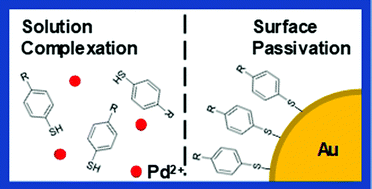Surface versus solution chemistry: manipulating nanoparticle shape and composition through metal–thiolate interactions†
Abstract
Nanostructures with well-defined crystallite sizes, shapes, and compositions are finding use in areas such as energy, security, and even medicine. Seeded growth is a promising strategy to achieve shape-controlled nanostructures, where specific structural features are often directed by the underlying symmetry of the seeds. Here, thiophenol derivatives capable of different metal–thiolate interactions were introduced into the synthesis of Au/Pd nanostructures by seed-mediated co-reduction. Our systematic analysis reveals that the symmetry and composition of the bimetallic nanoparticles (NPs) can be tuned as a function of additive binding strength and concentration, with symmetry reduction observed in some cases. Furthermore, additives with both thiol and amine functionalities facilitate random branching on the octahedral seed. Significantly, this synthetic versatility arises because the thiophenol derivatives modify both the surface capping of the growing nanostructures and the local ligand environment of the metal precursors, highlighting how the dual roles of synthesis components can be exploited to achieve high quality bimetallic nanostructures.



 Please wait while we load your content...
Please wait while we load your content...
